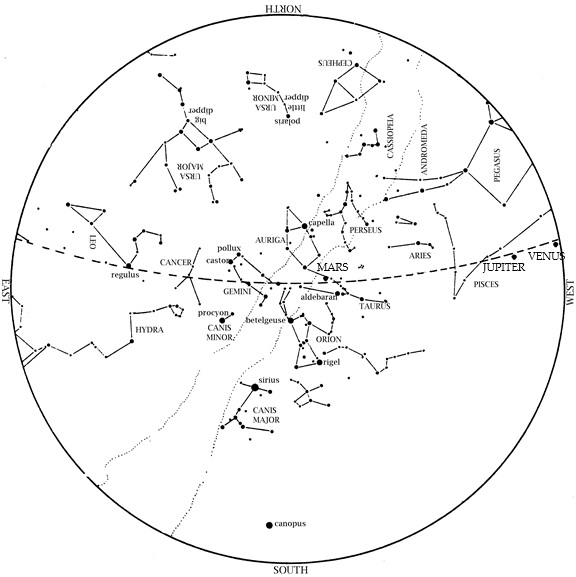Editor’s Note: It is a new year and we continue looking up as HMNS Astronomer James Wooten explains the sky happenings for the month of February, including Comet ZTF that remains in the sky.
Jupiter is still in the evening sky; look for it in the southwest at nightfall. Jupiter is brighter than any star we ever see at night.
Venus is higher in the evening sky this month. It is slightly higher in the southwest at dusk each evening. Watch as Venus approaches Jupiter during February; those planets are only about a half-degree apart on March 1.
Mars was up all night long in December, and is now almost overhead at dusk. As Earth continues to pull away from Mars, Mars is a little dimmer each evening. In February 2023, though, Mars still outshines most of the stars at night.
Saturn is behind the Sun and out of sight this month.
Taurus, the Bull is high in the south. Look for the Pleiades star cluster above reddish Aldebaran. Dazzling Orion, the Hunter takes center stage on winter evenings. Surrounding Orion are the brilliant stars of winter. Orion’s belt points down to Sirius, the Dog Star, which outshines all other stars we ever see at night. The Little Dog Star, Procyon, rises with Sirius and is level with Orion’s shoulder as they swing towards the south. To the upper left of Orion’s shoulder is Gemini, the Twins.
Under Sirius and low to the southern horizon this month is a star that most Americans never get to see—Canopus. Representing the bottom (keel) of the legendary ship Argo, Canopus is the second brightest star ever visible at night. Thus, it is clearly noticeable along the southern horizon on February and March evenings. However, you must be south of 37 degrees north to see Canopus rise. (This is the line that divides Utah, Colorado, and Kansas from Arizona, New Mexico, and Oklahoma.)

Taurus, the Bull, is almost overhead along with Gemini, the Twins. Mars is in Taurus. Dazzling Orion, the Hunter is high in the south, with his two dogs behind him. Sirius, the Big Dog Star, is the brightest star we ever see at night. Look for Canopus on the southern horizon below Sirius. Leo, the Lion, rises in the east. In the north, the Big Dipper has re-entered the evening sky. In the west at dusk, watch Venus approach Jupiter.
Moon Phases in February 2023
Full Feb. 5, 12:29 p.m.
Last Quarter Feb. 13, 10:01 a.m.
New Feb. 20, 1:06 a.m.
1st Quarter Feb. 27, 2:06 a.m.
Comet ZTF remains in the sky. Although it’s no longer as bright as it would have been if we could have seen it near February 1, it still might be visible in very dark skies, or in binoculars. Here is a good site to track its position: https://theskylive.com/planetarium?obj=c2022e3
Our George Observatory is now open every Saturday night for observing! Purchase tickets in advance on our website.
Clear Skies!
Looking for last month’s sky happenings? Click here.

